In Indiana Jones and the Last Crusade, Indie finds himself on a ledge before a chasm, with no obvious way across. Ignoring the evidence of his senses, he follows a clue he’s been given, takes a leap of faith and lands on an invisible plank. The proposed US Clean Power Rule puts Oregon and Washington, along with other Western states, on a ledge, too. Oregon and Washington are on a quest to meet their own self-imposed climate targets, but the federal rule seems to lead them astray, requiring different goals and tangential negotiations that will sap their energy and make it harder for them to reach their goal. What may not be apparent is that the rule also provides a plank: adopting a regional carbon price can substitute for complicated and ineffective power-rule compliance plans and let Oregon and Washington meet their own targets. It can also carry the West to a clean energy economy.
Backstory
The US Environmental Protection Agency (EPA), fulfilling its duty under the federal Clean Air Act to regulate CO2 emissions, has issued a proposed Clean Power Rule that would reduce CO2 pollution from power plants nationwide 30 percent below 2005 levels by 2030. Although Republicans think even this relatively modest goal is too much, Oregon and Washington already have more ambitious climate laws on the books. If Oregon follows a smooth line to its goal to cut pollution 75 percent below 1990 levels by 2050, it will cut pollution approximately 50 percent below 2005 levels by 2030. A straight line to Washington’s goal to cut pollution 50 percent below 1990 by 2050 will cut approximately 22 percent below 2005 levels by 2030, but the electricity sector will likely make deeper cuts than the state average. Both states aim to squeeze out much more pollution by 2050.
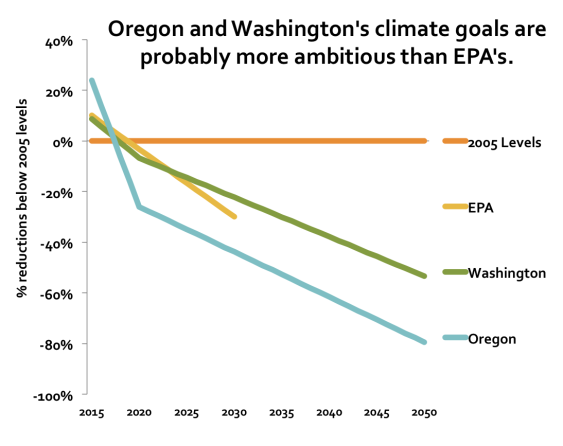
But this national pollution reduction number is just an estimate: instead of setting a national pollution goal, the Clean Power Rule sets carbon-intensity goals for each state’s in-state power generation. Each state must reduce the amount of carbon per kilowatt-hour of electricity it generates. Oregon must reduce the carbon-intensity of its power plants 48 percent by 2030, and Washington must curtail 72 percent by 2030. Each state must write a plan for meeting its goal.
Using a state-by-state approach to cut carbon from electricity will cost much more than a regional approach: $1.5 billion dollars more, according to EPA. The state-by-state approach is like Indiana Jones building a creaky and complicated pulley system instead of walking across the plank. EPA recognizes the perils of the pulley system and encourages states to collaborate. Legal scholars, taking that encouragement as a clue, have developed a legal framework that would allow states to use a regional carbon tax to comply with the federal rules.
Western states—many of them currently submitting anguished comments about the predicament the proposed rule would put them in—could follow the collaboration clue and propose a regional carbon price as their joint compliance plan. A regional carbon price would be the simplest, cheapest, most gaming-resistant strategy, and I’ll propose three types of regional price planks the states could step onto. First, though, I need to explain four ways that the Clean Power Rule’s state-by-state approach puts our Western heroes, especially Oregon and Washington, on a ledge with danger behind and (by appearances) nowhere to go, and three ways our heroes can prepare before leaping out into the void.
On the Ledge
The state-by-state approach might throw a wrench in state efforts to get off dirty power.
The state-by-state approach to carbon reduction complicates Oregon and Washington’s plans to meet their own state climate goals: cutting carbon pollution 75 percent below 1990 levels by 2050 (Oregon) and 50 percent below 1990 levels by 2050 (Washington). Meeting these goals requires the states to put themselves on a healthy, low-carbon diet. But the federal rule only requires states to make their home-cooked meals healthier; it says nothing about how many carbs states can eat via take-out from out-of-state. So the federal rule, perversely, encourages Oregon and Washington to abandon their kitchens and call for pizza. Ordering more coal-by-wire will let Oregon and Washington give a good report at their next federal Jenny Craig meeting, but will make it harder for them to stay on their own self-imposed carbon diets.
Here’s how electricity “take-out” works: much electricity in the West doesn’t stay home. It zaps and surges across state lines. The map below shows the US electricity grid, with its semi-autonomous provinces, each in a different set of shades. Texas, in yellow, has its own independent grid. The red and rose-tinted areas in the middle of the continent are their own power-sharing zone. And in the West, the vast territories in various hues of green comprise the Western Electricity Coordinating Council (WECC). The shades mark its sub-regions, such as the Northwest (NORW), which includes Idaho, Montana, Oregon, and Washington.
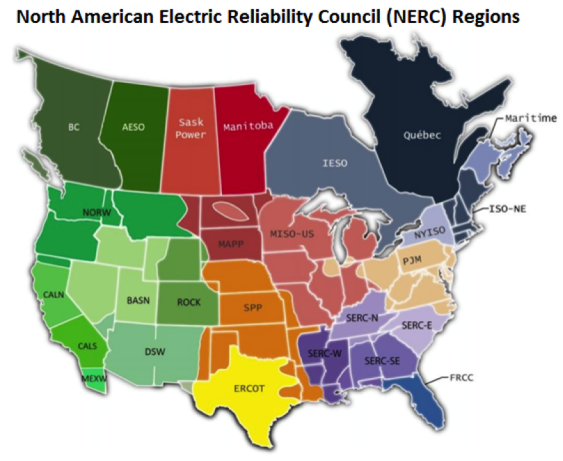
The Northwest region generates a lot of hydro electricity, but it also burns a lot of coal and that coal power gets around. Oregon and Washington have almost no coal plants generating power in-state, and what little they have will be completely gone in 2020 in Oregon when the Boardman plant shuts down, and in 2025 in Washington when the second Centralia coal plant closes. (Both of these closures are now required by state law as a result of agreements negotiated among state air-pollution regulators, state electricity-reliability regulators, utility watchdogs, and the plants’ owners.) But about a third of Oregon’s power use, and about a seventh of Washington’s, comes from coal. Most of that dirty coal power arrives by wire from Montana and Wyoming, states that pump out a lot more coal power than they use.
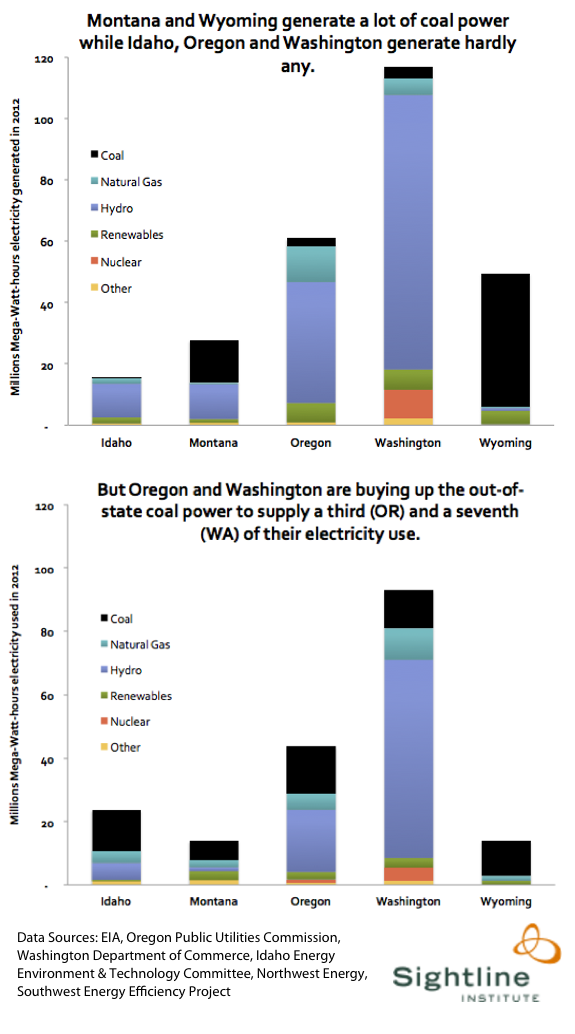
Paradoxically, the simplest way for Oregon and Washington to comply with the Clean Power Rule’s state-by-state formula (though not with their own climate laws) would be to increase their dirty power imports and use the juice to replace in-state natural gas-fired electricity. Oregon and Washington’s in-state power mix would be even more pristine than it is now, but they’d be boosting coal pollution in Montana and Wyoming. Bad for carbon pollution, bad for in-state natural gas plants, bad for the states’ plans to wean themselves off coal.
No, Indie, not that goblet!
The state-by-state approach doesn’t encourage energy efficiency.
The state-by-state approach, perversely, penalizes investments in the cheapest clean energy resource in the West. Oregon and Washington have known for years that efficiency is a key strategy for transitioning to clean energy because it is the cheapest, cleanest, fastest energy resource, and it creates local jobs and prosperity. (Oregon and Washington ranked #3 and #8 in the nation on the latest State Energy Efficiency Scorecard.)
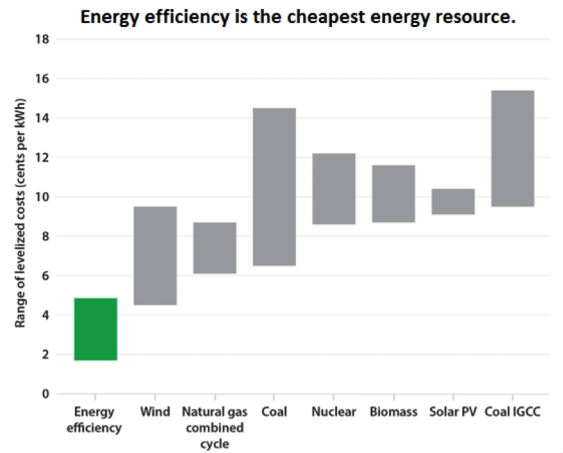
Investing in energy-efficient buildings creates more than twice as many jobs as spending the same money on coal power. Not only does coal power create fewer jobs, but for Oregon and Washington, those jobs are mostly—and soon all—out-of-state. In contrast, energy efficiency jobs are plentiful and local.
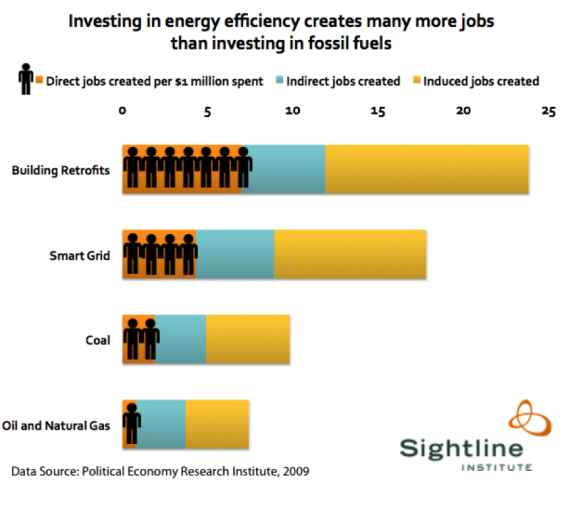
But the proposed federal rule would not let Oregon and Washington get clean power credit for most of their investments in energy efficiency. This raises costs as states and utilities will pass over cheap energy efficiency in favor of more expensive solutions that they know they can get credit for.
EPA may try to Band-Aid this problem by adding complicated accounting protocols to reflect energy efficiency, but added accounting just piles on administrative costs for EPA and the states (see Problem 3) and creates complexity that might leave the door open to gaming and fraud (see Problem 4).
The state-by-state approach is more expensive.
EPA estimates that a state-by-state approach will cost $1.5 billion more than would regional approaches. This extra cost stems from ignoring efficiency opportunities by not giving credit where credit is due and by letting laggards continue to doddle in the early years. States that have not yet invested in energy efficiency have the cheapest options still on the tree. A regional approach would snap up those apples before moving on to more expensive ones.
Similarly, cost-effective renewable resources might get left on the tree in a state-by-state approach. For example, existing transmission lines could cost-effectively bring juice from turbines in windy areas of Montana and Wyoming to power-hungry cities near the Pacific Coast. But if states are trying to match supply and demand within their own borders, they will miss such cross-border solutions. They might have to close down coal plants within their borders, thus cutting pollution but failing to drive investment towards clean technologies.
A state-by-state approach also costs more to administer and enforce: a particularly big concern for small states with few agency staff. A regional approach would use a uniform evaluation, measurement and verification methodology, lowering the administrative costs for participants. A family meal uses less packaging than individually wrapped servings.
The state-by-state approach could encourage gaming.
Different rules on different sides of a porous state border are an invitation for cheating. Well, not for cheating as such but for gaming the system: obeying the letter of the rule while subverting its purpose. Energy companies and governments will find and exploit the cracks that appear at the borders. States must use sophisticated modeling to prove compliance, but they could manipulate the models to indicate they have achieved their rate-based goal, even if they have not.
EPA may adjust its numbers to try to credit energy efficiency improvements to the state that put up the money. The calculations are complicated, though, and states will be motivated to provide the best-looking data to get the best adjustments from EPA. Oregon and Washington, with their stellar track record on energy efficiency and their soon-to-be-non-existent in-state coal plants are not positioned to benefit from gaming; states without a history of energy efficiency have more room to lobby EPA for a lower goal, based on exaggerated energy efficiency numbers. They can also more easily manipulate the accounting of their in-state energy efficiency programs.
Getting Ready to Leap
In short, a state-by-state approach is problematic for Oregon and Washington. Indy is in a tough spot. But EPA has offered up a plank by encouraging states to propose regional approaches. Here are some things Oregon and Washington could do to prepare and to make the most of the federal rule.
Get clarity: Ask EPA to specify state and regional pollution targets.
As mentioned above, if Oregon and Washington meet their state climate targets, they will meet or exceed EPA’s targets. But comparing Oregon and Washington’s state pollution targets (50 and 25 percent below 2012 levels by 2030) to the EPA’s pollution-intensity targets (48 percent and 72 percent less carbon per kilowatt-hour of in-state power generated by 2030) is a headache-inducing apples-to-oranges exercise. If you want a migraine, try to figure out how a multi-state target would compare to the state climate goals and to the state intensity goals. EPA encourages multi-state plans, but doesn’t say how to calculate a multi-state target.
EPA is soliciting comments on how to translate its rate-based goals to a pollution goal. Northwest states could ask EPA to specify actual carbon-quantity targets for each state and for the region. How much carbon, exactly, EPA? Just give us a number! Or they could suggest their own, and ask EPA approval. EPA admits that there is no simple method to convert from its rate-based (carbon intensity) goals to a mass-based (carbon pollution) goal. Before it can formulate a regional approach, the Northwest needs a pollution goal to aim for.
Grab the low-hanging fruit: Take advantage of cheap energy efficiency, low-cost renewables, and existing infrastructure.
Western states have opportunities to invest in energy efficiency (while creating local jobs). The easiest way to get credit for these investments is to simply put a price on carbon: this makes dirty power cost more and clean power, like efficiency and renewables, cost less. All the accounting anyone needs is right in the sticker price.
Western states also have many options for developing low-cost renewable energy in the region. A state-by-state approach means each state will develop renewables within their own borders, even if better wind sites are in neighboring jurisdictions. A regional approach takes advantage of the windiest and sunniest places in the Northwest, and of existing transmission lines. This regional approach could, ideally, be a regional price that drives investment to the best locations without the horse-trading. Or it could be a web of bilateral negotiations between states trading clean energy credit for investment and jobs.
I ran one simple scenario in which each state meets its own goals within its own borders by building renewables and shutting down coal, and one scenario in which the region meets a carbon-intensity reduction goal as a whole. The chart below shows the changes in in-state coal and renewables generation for each state under a state-by-state scenario (first bar) and regional scenario (second bar). In the state-by-state scenario, Oregon and Washington generate twice as much renewable energy in-state compared to the regional scenario. Because Oregon and Washington are not buying as much clean power from out-of-state, Montana and Wyoming shut down coal faster than they ramp up renewables. But in the regional scenario, Montana and Wyoming generate enough renewables to replace their coal, thus keeping the jobs and tax-base. They then sell the excess clean energy to Oregon and Washington, which get cheaper power.
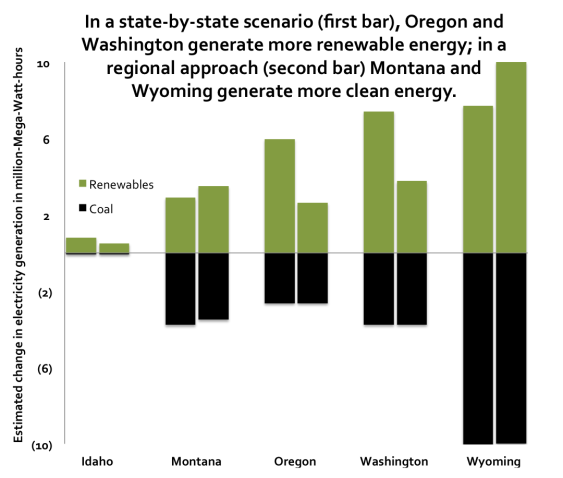
Have a plan: Use the Northwest Power and Conservation Council’s 7th Power Plan to guide a regional approach.
Whether or not western states pursue any of the carbon pricing options described below, they can use the Northwest Power and Conservation Council’s forthcoming 7th Power Plan to map the Northwest’s best path for complying with the Clean Power Rule. The Council facilitates cooperation among Idaho, Montana, Oregon, Washington, and the Bonneville Power Administration by creating long-term power plans. In the current 6th Power Plan, the Council modeled regional approaches to cutting carbon to meet a placeholder federal goal it anticipated would have arrived already (but which never did). Now, the Council can model the region’s approach to the Clean Power Act. But it needs a regional target to aim for.
The Leap
Oregon and Washington could try to meet their own state climate targets and the federal requirements and lead the region into a low-cost clean energy future all at once. It would be quite a jump, but here are three ways they could do it:
Use the California price.
The simplest way for western states to cross the chasm to a clean energy future where they all comply with EPA’s requirements and California, Oregon, and Washington also meet their state climate goals would be for them to put a regional price on carbon. A group of western states could propose to EPA that they use a regional carbon price—in concert with other state-based programs like energy efficiency and renewables policies—to meet a regional carbon goal. Ideally, the carbon price would include all twelve states in the western grid. However, the four tightly interconnected states of Idaho, Montana, Oregon, and Washington, or even just Oregon and Washington, could forge ahead without the others. A price would enable power plant owners, utilities, and utility regulators to plan for least-cost power without complicated accounting nor a web of bilateral agreements.
California is already talking about how to win approval from EPA for using its own cap-and-trade program as its plan for satisfying the Clean Power Rule. Other western states could then ride California’s coattails and use its cap price to meet EPA’s requirements.
Western states could either join California’s whole cap-and-trade program or they could peg a regional carbon tax to California’s allowance price, adjusting the tax once a year to match the average of the four most recent quarterly auction prices.
States have until June 2018 to submit a multi-state proposal to EPA. If EPA approved a western states proposal to use a cap-pegged carbon tax, each state would then apply the tax to energy consumed inside the state. It could use the revenue to reduce other taxes or pay for other state needs. Or it could invest in a clean-energy transition and reap the substantial rewards that RGGI has experienced. Just like in RGGI, the price would be regional but each state would make its own revenue choices.
The tax would not work in isolation: states would continue to pursue energy efficiency and renewable energy policies. But instead of calculating how much credit EPA would give them for these policies, the proof would be in the pudding: there is no carbon price on energy you never use. A carbon price would also, by raising the price of power, make more energy-efficiency investments cost effective.
An advantage of this approach from Oregon and Washington’s perspective is that California’s cap price is designed to achieve deeper carbon cuts, more in line with Oregon and Washington’s state goals than with the more lenient federal goal. Another advantage is that any state that wanted to use the price as its plan could do so without waiting for all western states to join.
Pros:
- Oregon and Washington will meet California’s state carbon goals.
- Regional approach decreases costs and risk of gaming.
- Flexibility for states wanting to join the regional price and those wanting to join the full cap-and-trade program.
- Minimal modeling and regulatory work (except for California).
- Each state gets to spend its own money.
- Some states could use the price for compliance even if not all states did.
Cons:
- Other states might not want to pay the California price.
Use a regional carbon tax.
Western states could make a proposal similar to the one above, but instead of pegging the carbon tax to California’s price, they could agree on a different tax trajectory. This option is a distant second to just using the California price, partly because the western states would have to do the legwork to convince EPA to accept their plan. The 7th Power Plan could model several scenarios and recommend a price trajectory most likely to get the Northwest to its regional target. EPA estimates the costs of cutting pollution range from $6 to $40 per ton, and national compliance might cost about $15 per ton in 2030, so a starting scenario might be a regional tax that starts at $5 per ton and increases to $15 (adjusted for inflation) per ton by 2030. A self-adjusting tax would be another option.
Another problem with this scenario, arguably a big one, is that the price needed to reach the federal target would likely be lower than the price needed to meet the states’ own targets. It would also create a rockier path to joining the California cap. Because the price for complying with the federal climate rule would be different than California’s price, if Oregon or Washington decided to join California, power sector regulators would have to figure out how to reconcile the two prices.
Pros:
- Simplified compliance with federal rule.
- Regional approach decreases costs and risk of gaming.
- Some price certainty.
- Certainty of meeting federal pollution goals.
- Each state gets to spend its own money.
Cons:
- Weaker federal goals could dampen Oregon and Washington’s beyond-carbon ambitions.
- Doesn’t cover industrial and transportation pollution.
Join RGGI.
If for whatever reason, western states chose not to implement their own carbon price, they could always join RGGI. This plank would be creaky and cracked compared to using the California price. Still, it would be better than the perilous pulleys of a state-by-state approach. Like California, RGGI has work to do to get the green light from EPA, but if it does, other states could simply join the RGGI cap. The power producers in the joining state would buy allowances in RGGI’s auctions, and the state government would get the money from the auction to spend as it saw fit. Northwest states could ride on RGGI’s coattails. They could take advantage of RGGI’s work in another way: using the systems RGGI has developed for emissions tracking, auctioning, and verifying compliance.
California’s cap is much more comprehensive than the Clean Power Rule: it will soon cover almost the entire economy. But RGGI, which only covers electricity, is a perfect fit. Unfortunately, RGGI is in a completely different regional grid. Joining RGGI doesn’t offer the same protections against porous borders that a west-wide program would. However, if enough western states joined RGGI, it could effectively create a “RGGI-West” that would cover some of the western grid, decreasing the danger of cross-border gaming.
Another problem with RGGI is that its price is so low that it will not propel Oregon and Washington to their own climate targets. They would need additional pollution-reduction policies; they might even need to add an additional carbon tax. Joining RGGI would also mean Oregon and Washington would forego the benefits of joining California.
Pros:
- Simplified compliance with federal rule.
- Each state gets to spend its own money.
Cons:
- Weaker federal goals could dampen Oregon and Washington’s beyond-carbon ambitions.
- Doesn’t cover industrial and transportation pollution.
- Precludes Northwest states from joining California.
A happy ending for Indy?
It is hard to see, but EPA has installed a plank to help Oregon and Washington, along with other western states, cross over to a clean-energy economy. A regional price would let Oregon and Washington meet their state climate targets and their federal climate requirements in a single leap, without pursuing arcane accounting or painful negotiations. The most inviting plank is the one that relies on California’s price: allowing a smooth transition for those states that want to join the full California cap and a simple solution for those who only want to meet their federal requirements. The Clean Power Rule puts the Northwest on a ledge, but Oregon, Washington and others could step out boldly with a regional carbon price.
Technical notes on graph showing difference in coal and renewables for state-by-state and regional approach:
- I used EPA’s Technical Support Document, Appendix 1 to calculate each state’s carbon intensity, following the methodology outlined in EPA’s Goal Computation Technical Support Document.
- To calculate the weighted regional intensity target, I multiplied each state’s intensity goal by its MWh of in-state generation, added these up, and divided by the total MWh generation of all the states.
- In both scenarios, I assumed that overall load growth in the region is flat. The latest Northwest Conservation Council’s Power Plan predicted a load growth of around 1.4 percent per year for the region, and EPA expects states to achieve 1.5 percent reductions per year from energy efficiency. So a flat load is a reasonable prediction.
- In both scenarios, I assumed that Oregon and Washington shut their in-state coal plants, as required by state law.
- In the state-by-state scenario, I assumed that each state had to meet its intensity goal on its own by adding in-state renewables and subtracting in-state coal generation. Because they had no coal, I assumed that Idaho, Oregon and Washington added in-state renewables until they met their target. This meant that all three of these states needed to add net in-state generation capacity, meaning that generation had to decrease elsewhere in order to balance a flat load. For Montana and Wyoming to meet their goals while keeping total regional generation flat, they needed to shut 1.3 MWh of coal for every 1 MWh of renewables they added. This let each state meet its intensity target alone, balanced out the total generation in the region, and reflected the expectation that Oregon and Washington would use their new in-state renewables to replace out-of-state coal.
- For the regional scenario, I assumed that Oregon and Washington built enough in-state renewables to replace their shuttered coal plants, but no more. I assumed that Montana and Wyoming built new renewables and shut down coal on a 1:1 basis until the region met its electricity demand and also met a weighted regional intensity target.

